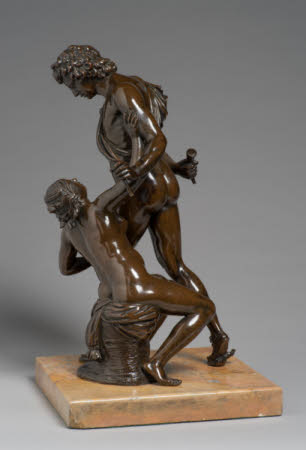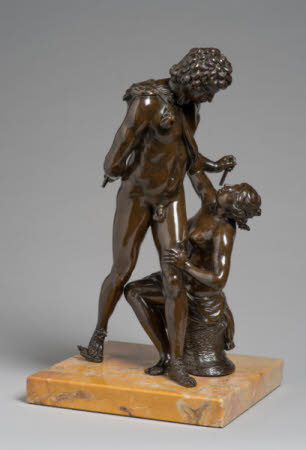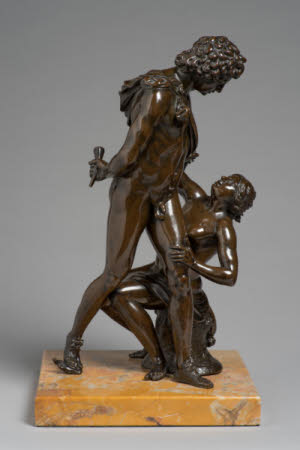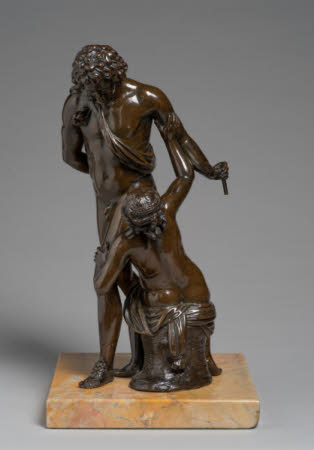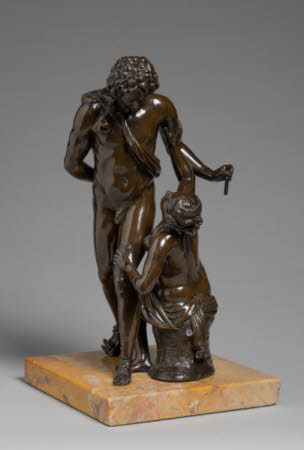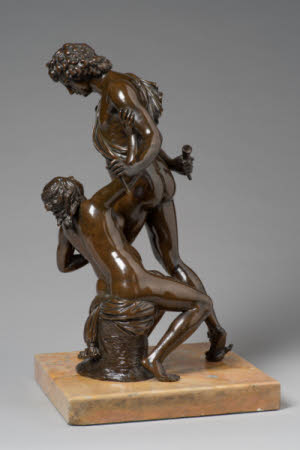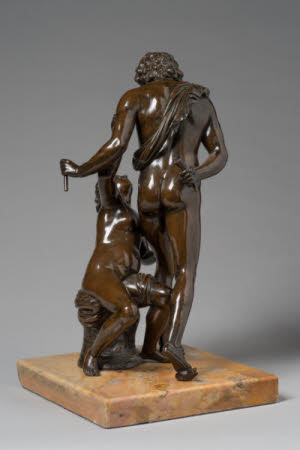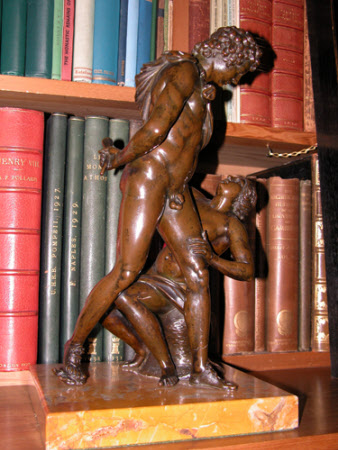Venus and Adonis
Giovanni Francesco Susini (Florence 1585- Florence 1653)
Category
Art / Sculpture
Date
1625 - 1630
Materials
Bronze on marble
Measurements
380 x 185 x 253 mm
Place of origin
Florence
Order this imageCollection
Anglesey Abbey, Cambridgeshire
NT 515032
Summary
Bronze on marble base, Venus and Adonis, Giovanni Francesco Susini (c.1585-1653), c.1625-30. The scene, taken from Ovid’s Metamorphoses (Book X), shows the young huntsman Adonis striding forward as he sets off for the hunt, with a spear (now largely broken-off) in his left hand and his hunting horn in his right hand, held concealed behind his back. He is naked except for a piece of drapery over his right shoulder, held in place by a strap. His lover the goddess Venus is seated on a tree stump, her dress cast off, serving as a cushion for her and running over her left thigh. She grasps hold of Adonis, imploring him not to set out on the hunt, a premonition having warned her that the outcome will be fatal. Adonis was indeed to meet his death whilst out hunting that day. In Ovid’s telling of the story, Venus then transformed her beloved’s blood into the anemone flower. Engraved with the French Royal Collection inventory number ‘No 199’ on the calf of Venus’s right leg. Cast in several sections; Adonis, whole body except left arm, including Venus’s left hand; Adonis’s left arm and Venus’s right arm; Venus’s left arm up to shoulder; Venus and tree stump. Surfaces very carefully finished. A break, repaired, in Adonis’s lower left leg. Mounted on marble base.
Full description
This remarkable bronze group depicts a perennially popular theme for artists, from the Renaissance onwards, the story of the fatal passion of Venus, goddess of love, for the young huntsman Adonis. Born from the incestuous union of King Cinyras of Paphos with his daughter Myrrha, Adonis became famed for his extraordinary beauty. Accidentally receiving a scratch from one of her son Cupid's arrows, Venus herself tumbled passionately into love with Adonis, becoming oblivious to everything except her feelings for the young man (Ovid, Metamorphoses, X, 516-59). Although she accompanied him on his hunting expeditions, Venus begged Adonis to beware the strength and violence of wild beasts. However, ignoring her warnings, he was gored to death by a fierce wild boar, dying in the arms of the grief-stricken goddess, who turned his blood into the anemone flower (Metamorphoses, X, 702-39). The bronze group depicts one of the dramatic events in the story, Venus's desperate efforts to hold back Adonis as the young man impatiently strains to return to the hunt. Her naked state, with her discarded robe acting as a cushion, and her abandoned posture hint that the couple have just made love, so that Adonis’s brusque rising to depart adds to the goddess’s distress. A note of humour is injected into the composition through Adonis’s concealment of his hunting horn behind his back. Giovanni Francesco Susini was the nephew and pupil of Giambologna’s former assistant Antonio Susini. He was trained in his uncle’s workshop in Florence, becoming a highly-skilled bronze-caster, although he also worked in marble. Between c.1624-26 he travelled to Rome, where he studied the famous sculptures of antiquity to be seen in the city. In the course of his career he made religious and secular works; his small bronze groups include reductions after antique marble sculptures, casts of models by Giambologna and his own inventions, of which the Venus and Adonis appears to be one. It is very similar in its conception and handling to another larger mythological bronze group depicting The Abduction of Helen by Paris, which is known in two versions, one in the Staatliche Kunstsammlungen Dresden signed and dated 1626, the other in the J. Paul Getty Museum, Los Angeles (Peggy Fogelman, Peter Fusco and Marietta Cambareri, Italian and Spanish Sculpture: Catalogue of the J. Paul Getty Museum Collection, Los Angeles 2002, pp. 190-99, no. 24). The Abduction of Helen is specifically recorded by Susini’s early biographer, Filippo Baldinucci (1624-97), as a composition of the sculptor’s own invention. It seems very likely that the Venus and Adonis, which owes much to the celebrated painting of this subject by Titian (see the example at Hatchlands Park, NT 1166206, and the old copy at Ham House, NT 1139673), was also Susini’s own invention. The Anglesey Abbey bronze is one of two versions of the model; the other was in the collection of the Marquesses of Bute until 1996, when it was acquired for the Robert H. Smith collection, Washington, in the catalogue of which it was convincingly attributed to Giovan Francesco Susini (Radcliffe/Penny 2004, pp. 280-85, no. 51, entry by Marietta Cambareri). Baldinucci does not mention the Venus and Adonis in his discussion of Susini and his works, although he does record a major bronze group, the subject of which he says he does not know, that the sculptor made and that was sent into France. The Anglesey Abbey bronze was in France from an early date. It is first certainly recorded in 1693, when King Louis XIV’s gardener André le Nôtre made a gift of his collections to his monarch. Among other works of art, the gift included a superlative series of bronzes which le Nôtre, who had begun collecting around 1650, acquired over a period of many years (for André le Nôtre and his collections, see Jules Guiffrey, ‘Testament et Inventaire après décès de André le Nostre et autres documents le concernant’, Bulletin de la Société de l’Histoire de l’Art Français, (1911), pp. 217–82; Antoine Schnapper, Curieux du Grand Siècle. Collections et collectionneurs dans la France du XVIIe siècle, Paris 1994, pp. 397-400). Jeremy Warren, 2019
Provenance
André le Nôtre (1613-1700); given to King Louis XIV in early May 1693; thence in the French Royal Collection until 1796; in 1796 ceded to the citoyen Jourdan (Antoine-Gabriel-Aimé Jourdan); sold at Jourdan sale, Paris, 4 April 1803, lot 112, ‘Autre groupe, sujet de Vénus assise, cherchant à retenir Adonis. Haut de 14 p.’; purchased by Urban Huttleston Rogers Broughton, 1st Lord Fairhaven (1896-1966), probably from David Black on 23 March 1949: ‘A fine early 17th-century Italian Bronze Group’ for £250; bequeathed to the National Trust by Lord Fairhaven with the house and the rest of the contents.
Credit line
Anglesey Abbey, The Fairhaven Collection (The National Trust)
Marks and inscriptions
Venus, right leg, near ankle: French Royal Collection inventory number: No 199
Makers and roles
Giovanni Francesco Susini (Florence 1585- Florence 1653), sculptor
References
Christie, Manson & Woods 1971: The National Trust, Anglesey Abbey, Cambridge. Inventory: Furniture, Textiles, Porcelain, Bronzes, Sculpture and Garden Ornaments’, 1971, p. 128, First Strong Room Wenley 1999: Robert Wenley, 'French Royal Bronzes in Great Britain', Apollo, 150, September 1999, pp. 3–12, pp. 9-12, figs. 18-19 Paris 1999: Les Bronzes de la Couronne, exh.cat., Musée du Louvre, Paris 1999, p. 137, no. 199 Anthea Brook, ‘Au département des Sculptures du Louvre, Bacchus et un satyre de Francesco Susini (1585-v. 1653)’, Revue du Louvre, (2003, no. 1), pp. 48-58, pp. 55-56, fig. 13 Radcliffe and Penny 2004: Anthony Radcliffe and Nicholas Penny, Art of the Renaissance Bronze 1500-1650, The Robert H. Smith Collection, London 2004, p. 280
